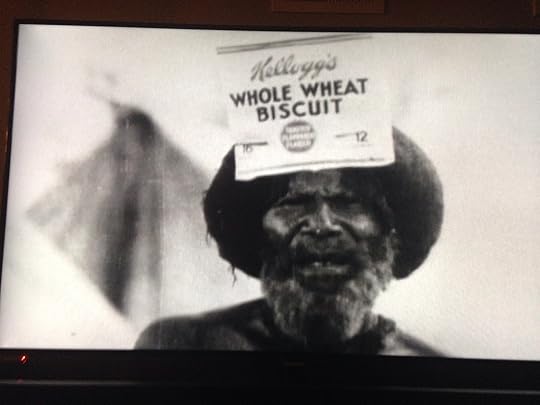The Big Mistake called “agriculture”
 From Guns, Germs, and Steel on public television
From Guns, Germs, and Steel on public television
Humans and agriculture share a 10,000-year history of codependence. If it weren’t for the tools, technology, and food availability permitted by the development of agriculture, human civilization would surely look very different today. Agriculture brought an end to nomadic hunter-gatherer life, increased crop yields and freed up time previously spent on food procurement. This allowed humans to specialize as teachers, metal workers, builders, and soldiers. Once crops were cultivated, rather than just harvested wild, they too underwent changes at the hands of humans and were propagated over large areas.
But agriculture did not come without a price, both social and for health. Jared Diamond, PhD, author of the Pulitzer Prize-winning book, Guns, Germs, and Steel, had this to say about agriculture:
“Hunter-gatherers practiced the most successful and longest-lasting life style in human history. In contrast, we’re still struggling with the mess into which agriculture has tumbled us, and it’s unclear whether we can solve it. Suppose that an archaeologist who had visited from outer space were trying to explain human history to his fellow spacelings. He might illustrate the results of his digs by a 24-hour clock on which one hour represents 100,000 years of real past time. If the history of the human race began at midnight, then we would now be almost at the end of our first day. We lived as hunter-gatherers for nearly the whole of that day, from midnight through dawn, noon, and sunset. Finally, at 11:54 p. m. we adopted agriculture. As our second midnight approaches, will the plight of famine-stricken peasants gradually spread to engulf us all? Or will we somehow achieve those seductive blessings that we imagine behind agriculture’s glittering facade, and that have so far eluded us?”
(From Discover Magazine, 1987. The Worst Mistake in the History of the Human Race at http://www.ditext.com/diamond/mistake....)
The photograph accompanying this blog post is a still frame from Dr. Diamond’s public television production, Guns, Germs, and Steel, showing a native New Guinean man’s interpretation of uses for packaging and wheat, some of the perplexing “cargo” encountered by stone-age people unaccustomed to consuming the seeds of grasses.
In Dr. Diamond’s compressed clock timeline, at 11:54 pm of our day on this planet we embraced the seeds of grasses to get our agricultural efforts started, including einkorn wheat and barley in the Fertile Crescent, teosinte and maize in central America, millet and sorghum in sub-Saharan Africa, and rice in southeast Asia. Resorting to the seeds of grasses for food in times of desperation evolved over time to become staple: foods expected as part of the routine diet.
We’ve taken the “seeds of grass” food paradigm to its absurd extreme today, thanks to the cheap, easy, surplus calories afforded by modern agriculture with its herbicides, pesticides, methods of genetically altering crop that yield vast fields of monoculture crops, compounded by misguided advice to base the human diet largely on “healthy whole grains.” The food of desperation, sought only when real food was unavailable, added just a moment in time ago, has now come to dominate the human diet. Wheat and corn alone–both seeds of grasses–now provide 50% of all human calories on all 7 continents. Yes, agriculture has the potential to yield food surpluses and parallels the human experience for the last 300 generations, but it also invited compromises in nutrition that largely explain why we have the fattest, most diabetic population with more psychiatric disease, skin conditions, gastrointestinal struggles, and autoimmune diseases than any other species that has ever walked the earth.
In my new book, Wheat Belly Total Health (to be released Sept 16, 2014), I elaborate on this cataclysmic shift in how and what we perceive as food and why, as Dr. Diamond puts it, we can count it as among the worst mistakes ever made by humans. Understanding the full implications of this mistake sets you on a new course in truly understanding nutrition, weight, and health in ways that you never imagined. More to come . . .
The post The Big Mistake called “agriculture” appeared first on Dr. William Davis.
Dr. Davis Infinite Health Blog
Recognize that this i The insights and strategies you can learn about in Dr. Davis' Infinite Health Blog are those that you can put to work to regain magnificent health, slenderness, and youthfulness.
Recognize that this is NOT what your doctor or the healthcare system provides, as they are mostly interested in dispensing pharmaceuticals and procedures to generate revenues. The healthcare INDUSTRY is not concerned with health--you must therefore take the reins yourself.
Dr. Davis focuses on:
--Real, powerful nutritional strategies
--Addresing nutrient deficiencies unique to modern lifestyles
--Deep insights into rebuilding the microbiome disrupted by so many modern factors
Follow Dr. Davis here and on social media and you can witness the extraordinary successes people enjoy on his programs. ...more
- William Davis's profile
- 160 followers



